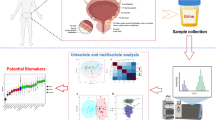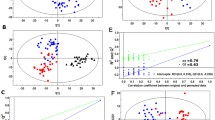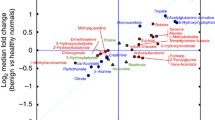Abstract
Introduction
Bladder cancer (BCa) is one of the most common and aggressive cancers. It is the sixth most frequently occurring cancer in men and its rate of occurrence increases with age. The current method of BCa diagnosis includes a cystoscopy and biopsy. This process is expensive, unpleasant, and may have severe side effects. Recent growth in the power and accessibility of machine-learning software has allowed for the development of new, non-invasive diagnostic methods whose accuracy and sensitivity are uncompromising to function.
Objectives
The goal of this research was to elucidate the biomarkers including metabolites and corresponding genes for different stages of BCa, show their distinguishing and common features, and create a machine-learning model for classification of stages of BCa.
Methods
Sets of metabolites for early and late stages, as well as common for both stages were analyzed using MetaboAnalyst and Ingenuity® Pathway Analysis (IPA®) software. Machine-learning methods were utilized in the development of a binary classifier for early- and late-stage metabolites of BCa. Metabolites were quantitatively characterized using EDragon 1.0 software. The two modeling methods used are Multilayer Perceptron (MLP) and Stochastic Gradient Descent (SGD) with a logistic regression loss function.
Results
We explored metabolic pathways related to early-stage BCa (Galactose metabolism and Starch and sucrose metabolism) and to late-stage BCa (Glycine, serine, and threonine metabolism, Arginine and proline metabolism, Glycerophospholipid metabolism, and Galactose metabolism) as well as those common to both stages pathways. The central metabolite impacting the most cancerogenic genes (AKT, EGFR, MAPK3) in early stage is d-glucose, while late-stage BCa is characterized by significant fold changes in several metabolites: glycerol, choline, 13(S)-hydroxyoctadecadienoic acid, 2′-fucosyllactose. Insulin was also seen to play an important role in late stages of BCa. The best performing model was able to predict metabolite class with an accuracy of 82.54% and the area under precision-recall curve (PRC) of 0.84 on the training set. The same model was applied to three separate sets of metabolites obtained from public sources, one set of the late-stage metabolites and two sets of the early-stage metabolites. The model was better at predicting early-stage metabolites with accuracies of 72% (18/25) and 95% (19/20) on the early sets, and an accuracy of 65.45% (36/55) on the late-stage metabolite set.
Conclusion
By examining the biomarkers present in the urine samples of BCa patients as compared with normal patients, the biomarkers associated with this cancer can be pinpointed and lead to the elucidation of affected metabolic pathways that are specific to different stages of cancer. Development of machine-learning model including metabolites and their chemical descriptors made it possible to achieve considerable accuracy of prediction of stages of BCa.







Similar content being viewed by others
References
Aguer, C., Gambarotta, D., Mailloux, R. J., Moffat, C., Dent, R., McPherson, R., et al. (2011). Galactose enhances oxidative metabolism and reveals mitochondrial dysfunction in human primary muscle cells. PLoS ONE, 6(12), e28536.
Amelio, I., Cutruzzolá, F., Antonov, A., Agostini, M., & Melino, G. (2014). Serine and glycine metabolism in cancer. Trends in Biochemical Sciences, 39(4), 191–198.
Brown, D. G., Rao, S., Weir, T. L., O’Malia, J., Bazan, M., Brown, R. J., et al. (2016). Metabolomics and metabolic pathway networks from human colorectal cancers, adjacent mucosa, and stool. Cancer & Metabolism, 4, 11.
Burger, M., Catto, J. W., Dalbagni, G., Grossman, H. B., Herr, H., Karakiewicz, P., et al. (2013). Epidemiology and risk factors of urothelial bladder cancer. European Urology, 63(2), 234–241.
Cao, M., Zhao, L., Chen, H., Xue, W., & Lin, D. (2012). NMR-based metabolomic analysis of human bladder cancer. Analytical Sciences, 28(5), 451–456.
Chen, W. Y., Wu, F., You, Z. Y., Zhang, Z. M., Guo, Y. L., & Zhong, L. X. (2015). Analyzing the differentially expressed genes and pathway cross-talk in aggressive breast cancer. Journal of Obstetrics and Gynaecology, 41(1), 132–140.
Chen, T., Xie, G., Wang, X., Fan, J., Qiu, Y., Zheng, X., et al. (2011). Serum and urine metabolite profiling reveals potential biomarkers of human hepatocellular carcinoma. Molecular and Cellular Proteomics, 10(7), M110.004945.
Cheng, X., Liu, X., Liu, X., Guo, Z., Sun, H., Zhang, M., et al. (2018). Metabolomics of non-muscle invasive bladder cancer: biomarkers for early detection of bladder cancer. Frontiers in Oncology, 8, 494.
Cheng, J., Zheng, G., Jin, H., & Gao, X. (2017). Towards tyrosine metabolism in esophageal squamous cell carcinoma. Combinatorial Chemistry & High Throughput Screening, 20(2), 133–139.
Chong, J., Soufan, O., Li, C., Caraus, I., Li, S., Bourque, G., et al. (2018). MetaboAnalyst 4.0: Towards more transparent and integrative metabolomics analysis. Nucleic Acids Research, 46(W1), W486–W494.
Coloff, J. L., Murphy, J. P., Braun, C. R., Harris, I. S., Shelton, L. M., Kami, K., et al. (2016). Differential glutamate metabolism in proliferating and quiescent mammary epithelial cells. Cell Metabolism, 23(5), 867–880.
Conde, V. R., Oliveira, P. F., Nunes, A. R., Rocha, C. S., Ramalhosa, E., Pereira, J. A., et al. (2015). The progression from a lower to a higher invasive stage of bladder cancer is associated with severe alterations in glucose and pyruvate metabolism. Experimental Cell Research, 335(1), 91–98.
Córdoba-Chacón, J., Gahete, M. D., Pozo-Salas, A. I., Castaño, J. P., Kineman, R. D., & Luqu, E. R. M. (2013). Endogenous somatostatin is critical in regulating the acute effects of l-arginine on growth hormone and insulin release in mice. Endocrinology, 154(7), 2393–2398.
Ferdosi, S., Ho, T. H., Castle, E. P., Stanton, M. L., Borges, C. H., & Ahmad, A. (2018). Behavior of blood plasma glycan features in bladder cancer. PLoS One, 13(7), e0201208.
Feron, O. (2009). Pyruvate into lactate and back: From the Warburg effect to symbiotic energy fuel exchange in cancer cells. Radiotherapy and Oncology, 92(3), 329–333.
Frank, E., Hall, M. A., & Witten, I. H. (2016). The WEKA workbench. Online Appendix for Data Mining: Practical Machine Learning Tools and Techniques (4th ed.). Morgan Kaufmann Series in Data Managing Systems. San Francisco, Calif., USA: Morgan Kauffman Publishers, Inc. https://www.cs.waikato.ac.nz/ml/weka/Witten_et_al_2016_appendix.pdf.
Gallo, E. F., & Iadecola, C. (2011). Neuronal nitric oxide contributes to neuroplasticity-associated protein expression through cGMP, protein kinase G, and extracellular signal-regulated kinase. Journal of Neuroscience, 31(19), 6947–6955.
Gamagedara, S., Shi, H., & Ma, Y. (2012). Quantitative determination of taurine and related biomarkers in urine by liquid chromatography-tandem mass spectrometry. Analytical and Bioanalytical Chemistry, 402(2), 763–770.
Garcia-Bermudez, J., Baudrier, L., La, K., Zhu, X. G., Fidelin, J., Sviderskiy, V. O., et al. (2018). Aspartate is a limiting metabolite for cancer cell proliferation under hypoxia and in tumours. Nature Cell Biology, 20(7), 775–781.
Grau, M., Pauly, S., Ali, J., Walpurgis, K., Thevis, M., Bloch, W., et al. (2013). RBC-NOS-dependent S-nitrosylation of cytoskeletal proteins improves RBC deformability. PLoS ONE, 8(2), e56759.
Hall, M., Frank, E., Holmes, G., Pfahringer, B., Reutemann, P., & Witten, I. H. (2009). The WEKA data mining software: An update. ACM SIGKDD Explorations Newsletter, 11(1), 10–18.
IPA Fall 2018 Release Is Here! Now with faster functionalities and more than 49,000 datasets available for Analysis Match! https://www.qiagenbioinformatics.com/products/ingenuity-pathway-analysis.
Issaq, H. J., Nativ, O., Waybright, T., Luke, B., Veenstra, T. D., Issaq, E. J., et al. (2018). Detection of bladder cancer in human urine by metabolomic profiling using high performance liquid chromatography/mass spectrometry. Journal of Urology, 179(6), 2422–2426.
Jin, X., Yun, S. J., Jeong, P., Kim, I. Y., Kim, W. J., & Park, S. (2014). Diagnosis of bladder cancer and prediction of survival by urinary metabolomics. Oncotarget, 5(6), 1635–1645.
Kajiwara, A., Tsuchiya, Y., Takata, T., Nyunoya, M., Nozaki, N., Ihara, H., et al. (2013). Nitric oxide enhances increase in cytosolic Ca(2 +) and promotes nicotine-triggered MAPK pathway in PC12 cells. Nitric Oxide, 34, 3–9.
Karin, M. (1995). The regulation of AP-1 activity by mitogen-activated protein kinases. Journal of Biological Chemistry, 270(28), 16485–16486.
Kim, K., Taylor, S. L., Ganti, S., Guo, L., Osier, M. V., & Weiss, R. H. (2011). Urine metabolomic analysis identifies potential biomarkers and pathogenic pathways in kidney cancer. OMICS: A Journal of Integrative Biology, 15(5), 293–303.
Kim, W. T., Yun, S., Yan, C., Jeong, P., Kim, Y. H., Lee, I. S., et al. (2016). Metabolic pathway signatures associated with urinary metabolite biomarkers differentiate bladder cancer patients from healthy controls. Yonsei Medical Journal, 57(4), 865–871.
KO (KEGG ORTHOLOGY) Database. https://www.genome.jp/kegg/ko.html.
Krämer, A., Green, J., Pollard, J., Jr., & Tugendreich, S. (2014). Causal analysis approaches in Ingenuity Pathway Analysis. Bioinformatics, 30(4), 523–530.
Kuriakose, T., Rada, B., & Watford, W. T. (2014). Tumor progression locus 2-dependent oxidative burst drives phosphorylation of extracellular signal-regulated kinase during TLR3 and 9 signaling. Journal of Biological Chemistry, 289(52), 36089–36100.
Lee, M., Cho, T., Jantaratnotai, N., Wang, Y. T., McGeer, E., & McGeer, P. L. (2010). Depletion of GSH in glial cells induces neurotoxicity: Relevance to aging and degenerative neurological diseases. The FASEB Journal, 24(7), 2533–2545.
Lin, W. T., Yang, S. C., Tsai, S. C., Huang, C. C., & Lee, N. Y. (2006). L-Arginine attenuates xanthine oxidase and myeloperoxidase activities in hearts of rats during exhaustive exercise. British Journal of Nutrition, 95(1), 67–75.
Liu, X., Cheng, X., Liu, X., He, L., Zhang, W., Wang, Y., et al. (2018). Investigation of the urinary metabolic variations and the application in bladder cancer biomarker discovery. International Journal of Cancer, 143(2), 408–418.
Machine Learning at Waikato University. https://www.cs.waikato.ac.nz/ml/index.html.
McDunn, J. E., Perichon, R., Neri, B., & Wittmann, B. (2015). Biomarkers for bladder cancer and methods using the same. US Patent. Pub. No.: US 2015/0065366 A1, 3/5/2015. https://patentimages.storage.googleapis.com/42/d3/37/b454c930e66f77/US20150065366A1.pdf
MetaboAnalyst—statistical, functional and integrative analysis of metabolomics data. http://www.metaboanalyst.ca/.
Mpanga, A. Y., Siluk, D., Jacyna, J., Szerkus, O., Wawrzyniak, R., Markuszewski, M., et al. (2018). Targeted metabolomics in bladder cancer: From analytical methods development and validation towards application to clinical samples. Analytica Chimica Acta, 1037, 188–199.
Nakamura, Y., Katagiri, T & Nakatsuru, S. (2012). Method of diagnosing bladder cancer. US Patent 7998695B2.
Oliveros, J.C. (2007–2015) VENNY. An interactive tool for comparing lists with Venn Diagrams. Venny 2.1. http://bioinfogp.cnb.csic.es/tools/venny/index.html.
Pasikanti, K. K., Esuvaranathan, K., Hong, Y., Ho, P. C., Mahendran, R., Raman Nee Mani, L., et al. (2013). Urinary metabotyping of bladder cancer using two-dimensional gas chromatography time-of-flight mass spectrometry. Journal of Proteome Research, 12(9), 3865–3873. https://doi.org/10.1021/pr4000448.
Perroud, B., Lee, J., Valkova, N., Dhirapong, A., Lin, P. Y., Fiehn, O., et al. (2006). Pathway analysis of kidney cancer using proteomics and metabolic profiling. Molecular Cancer, 5, 64.
Poirion, B. O., Chaudhary, K., & Garmire, L. X. (2018). Deep learning data integration for better risk stratification models of bladder cancer. AMIA Joint Summits on Translational Science Proceedings, 2017, 197–206.
Priolo, C., Pyne, S., Rose, J., Regan, E. R., Zadra, G., Photopoulos, C., et al. (2014). AKT1 and MYC induce distinctive metabolic fingerprints in human prostate cancer. Cancer Research, 74(24), 7198–7204.
Puchades-Carrasco, L., Jantus-Lewintre, E., Pérez-Rambla, C., García-García, F., Lucas, R., Calabuig, S., et al. (2016). Serum metabolomic profiling facilitates the non-invasive identification of metabolic biomarkers associated with the onset and progression of non-small cell lung cancer. Oncotarget, 7(11), 12904–12916.
Rodrigues, D., Jeronimo, C., Henrique, R., Belo, L., de Lourdes Basto, S. M., & de Pinho, P. G. (2016). Biomarkers in bladder cancer: A metabolomic approach using in vitro and ex vivo model systems. International Journal of Cancer, 139(2), 256–268.
Sahu, D., Lotan, Y., Wittmann, B., Neri, B., & Hansel, D. E. (2017). Metabolomics analysis reveals distinct profiles of nonmuscle-invasive and muscle-invasive bladder cancer. Cancer Medicine, 6(9), 2106–2120.
Schoeppner, H. L., Raz, A., Ho, S. B., & Bresalier, R. S. (1995). Expression of an endogenous galactose-binding lectin correlates with neoplastic progression in the colon. Cancer, 75(12), 2818–2826.
Shen, C., Sun, A., Chen, D., Su, X., Jiang, J., Li, G., et al. (2015). Developing urinary metabolomic signatures as early bladder cancer diagnostic markers. OMICS: A Journal of Integrative Biology, 19(1), 1–11.
Shyh-Chang, N., Locasale, J. W., Lyssiotis, C. A., Zheng, Y., Teo, R. Y., Ratanasirintrawoot, S., et al. (2013). Influence of threonine metabolism on S-adenosylmethionine and histone methylation. Science, 339(6116), 222–226.
Siegel, R. L., Miller, K. D., & Jemal, A. (2018). Cancer statistics, 2018. CA: A Cancer Journal for Clinicians, 68(1), 7–30.
Srivastava, S., Roy, R., Singh, S., Kumar, P., Dalela, D., Sankhwar, S. N., et al. (2010). Taurine—a possible fingerprint biomarker in non-muscle invasive bladder cancer: A pilot study by 1H NMR spectroscopy. Cancer Biomarkers, 6(1), 11–20.
Tetko, I. V., Gasteiger, J., Todeschini, R., Mauri, A., Livingstone, D., Ertl, P, et al. (2005). Virtual computational chemistry laboratory—design and description. Journal of Computer Aided Molecular Design, 19, 453–463. VCCLAB, Virtual Computational Chemistry Laboratory. http://www.vcclab.org.
Tibbles, L. A., & Woodgett, J. R. (1999). The stress-activated protein kinase pathways. Cellular and Molecular Life Sciences, 55(10), 1230–1254.
Tsigelny, I. F. (2018). Artificial intelligence in drug combination therapy. Briefings in Bioinformatics, bby004, https://doi.org/10.1093/bib/bby004.
Venn, J. (1880). On the employment of geometrical diagrams for the sensible representations of logical propositions. Proceedings of the Cambridge Philoophical Society, 4, 47–59.
von Rundstedt, F. C., Rajapakshe, K., Ma, J., Arnold, J. M., Gohlke, J., Putluri, V., et al. (2016). Integrative pathway analysis of metabolic signature in bladder cancer: A linkage to the cancer genome atlas project and prediction of survival. Journal of Urology, 195(6), 1911–1919.
Wang, Y., Zhao, F., Jin, Y., Zhong, Y., Yu, X., Li, G., et al. (2011). Effects of exogenous glutathione on arsenic burden and NO metabolism in brain of mice exposed to arsenite through drinking water. Archives of Toxicology, 85(3), 177–184.
Wartenberg, M., Ling, F. C., Schallenberg, M., Bäumer, A. T., Petrat, K., Hescheler, J., et al. (2001). Down-regulation of intrinsic P-glycoprotein expression in multicellular prostate tumor spheroids by reactive oxygen species. Journal of Biological Chemistry, 276(20), 17420–17428.
Weka 3: Data Mining Software in Java. https://www.cs.waikato.ac.nz/ml/weka/index.html.
Welcome to HMDB Version 4.0. Retrieved October 23, 2018http://www.hmdb.ca/.
Whitten, H., Frank, E., Hall, M. & Pal, C. J. (2016). Data Mining: Practical Machine Learning Tools and Techniques (4th ed., pp. 553–572). Morgan Kaufmann Publishers, Inc., Cambridge, Mass., USA; The WEKA Workbench. Appendix B.
Wishart, D. S., Feunang, Y. D., Marcu, A., Guo, A. C., Liang, K., Vázquez-Fresno, R., et al. (2018). HMDB 4.0—The Human Metabolome Database for 2018. Nucleic Acids Research, 46(D1), D608–D617.
Wittmann, B. M., Stirdivant, S. M., Mitchell, M. W., Wulff, J. E., McDunn, J. E., Li, Z., et al. (2014). Bladder cancer biomarker discovery using global metabolomic profiling of urine. PLoS ONE, 9(12), e115870.
Wu, H., Liu, T., Ma, C., Xue, R., Deng, C., Zeng, H., et al. (2011). GC/MS-based metabolomic approach to validate the role of urinary sarcosine and target biomarkers for human prostate cancer by microwave-assisted derivatization. Analytical and Bioanalytical Chemistry, 401(2), 635–646.
Yigiter, M., Halici, Z., Odabasoglu, F., Keles, O. N., Atalay, F., Unal, B., et al. (2011). Growth hormone reduces tissue damage in rat ovaries subjected to torsion and detorsion: Biochemical and histopathologic evaluation. European Journal of Obstetrics & Gynecology and Reproductive Biology, 157(1), 94–100.
Zaravinos, A., Pieri, M., Mourmouras, N., Anastasiadou, N., Zouvani, I., Delakas, D., et al. (2014). Altered metabolic pathways in clear cell renal cell carcinoma: A meta-analysis and validation study focused on the deregulated genes and their associated networks. Oncoscience, 1(2), 117–131.
Zhao, J., Xu, W., He, M., Zhang, Z., Zeng, S., Ma, C., et al. (2016). Whole-exome sequencing of muscle-invasive bladder cancer identifies recurrent copy number variation in IPO11 and prognostic significance of importin-11 overexpression on poor survival. Oncotarget, 7(46), 75648–75658.
Zhou, Y., Song, E., Ma, C., Zhou, L., Liu, X., Yin, P., et al. (2017). Discovery and validation of potential urinary biomarkers for bladder cancer diagnosis using a pseudotargeted GC-MS metabolomics method. Oncotarget, 8(13), 20719–20728.
Zhu, Y., Bian, X. J., Ye, D. W., Yao, X. D., Zhang, S. L., Dai, B., et al. (2014). Long noncoding RNA expression signatures of bladder cancer revealed by microarray. Oncology Letters, 7(4), 1197–1202.
Author information
Authors and Affiliations
Contributions
VK and IT designed the research. EK coordinated the data collection. VK, IT and EK analyzed the data and wrote the manuscript. AZ and ER created the data set for machine learning and executed it. All authors read and approved the manuscript.
Corresponding author
Ethics declarations
Conflict of interest
The authors declare that they have no conflict of interest.
Research involving human and animal participants
This article does not contain any studies with human and/or animal participants performed by any of the authors.
Additional information
Publisher's Note
Springer Nature remains neutral with regard to jurisdictional claims in published maps and institutional affiliations.
Electronic supplementary material
Below is the link to the electronic supplementary material.
Rights and permissions
About this article
Cite this article
Kouznetsova, V.L., Kim, E., Romm, E.L. et al. Recognition of early and late stages of bladder cancer using metabolites and machine learning. Metabolomics 15, 94 (2019). https://doi.org/10.1007/s11306-019-1555-9
Received:
Accepted:
Published:
DOI: https://doi.org/10.1007/s11306-019-1555-9




